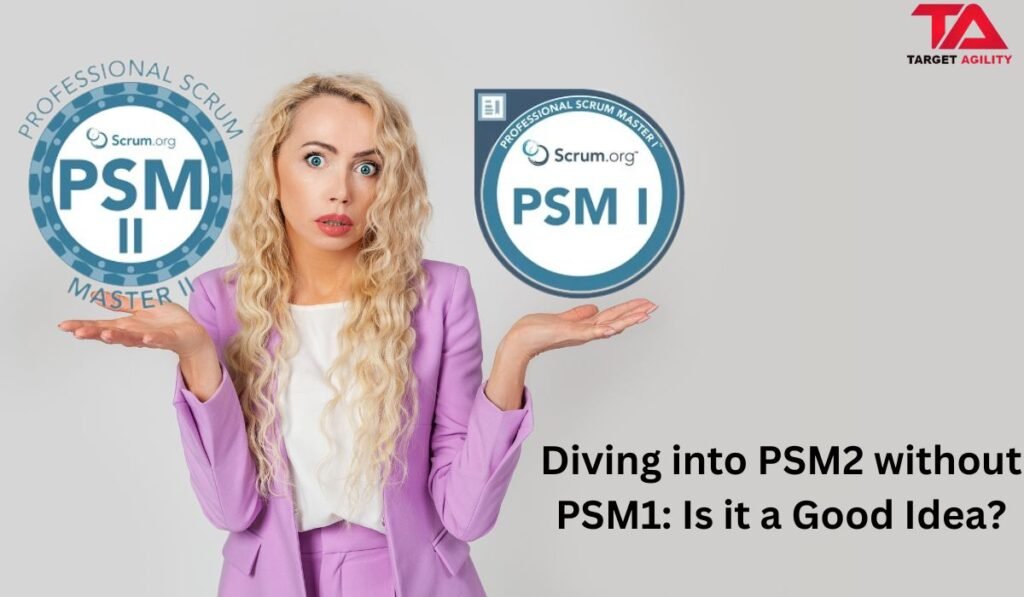Diving into PSM2 without PSM1: Is it a Good Idea?

In the world of project management and agile methods, Scrum is a big deal. Getting certified in Professional Scrum Master (PSM) shows you know your stuff when it comes to Scrum. But what if you want to jump straight to PSM2 without doing PSM1 first? Let’s break it down. Scrum Certifications 101 First things first, let’s talk about Scrum certifications. PSM1 is like the starting point, testing your basic understanding of Scrum. It covers the basics like the Scrum framework, roles, events, and artifacts. PSM2 comes next, delving into more advanced concepts and how you can use Scrum in tricky situations. PSM1: Is it a Must? Now, the big question: do you have to do PSM1 before PSM2? Nope, it’s not a must. Scrum.org, the folks behind these certifications, don’t say you have to do PSM1 first. But, there’s a catch. Skipping PSM1 means you’re skipping the basics, and that can have consequences. What PSM1 Gives You PSM1 is like a launching pad. It gets you comfortable with the basics of Scrum. Skipping it means you’re jumping into the deep end without knowing how to swim. PSM2 Without PSM1: Challenges Here are the challenges you might face going straight to PSM2: 1. What You Don’t Know: PSM2 assumes you know the basics from PSM1. Without that, you might find it tough to understand the advanced stuff. 2. Applying the Knowledge: PSM2 isn’t just about knowing stuff; it’s about using Scrum in tricky situations. PSM1 prepares you for this. Without it, applying what you know in PSM2 could be tough. 3. It’s a Bit Tougher: PSM2 is more advanced, and without PSM1, you might find it harder to pick up on the complex parts of Scrum. How to Make it Work If you’re set on doing PSM2 without PSM1, here are some tips: 1. Study Hard: Learn as much as you can about Scrum from books, websites, and real-world examples. 2. Try it Out: Get involved in Scrum projects or teams. Putting what you learn into practice helps a lot. 3. Get Help: Connect with experienced Scrum folks. Having a mentor can guide you and make things a bit easier. The Bottom Line The choice to skip PSM1 and head straight to PSM2 is entirely up to you. Whether you go the usual PSM1-PSM2 way or take the direct route to PSM2, what matters most is understanding Scrum, using it in your work, and keeping the Scrum spirit alive. It’s not just about certifications; it’s about living and breathing Scrum every day.
PSM vs. CSM: Which Agile Certification Is Best for You?

When you work in areas like software development and project management, you often hear about Agile methods, with Scrum being a popular one. To become an expert in Scrum, many people get certified. Two common certifications are Professional Scrum Master (PSM) and Certified ScrumMaster (CSM). In this blog, we’ll help you decide which one is right for you by explaining the key differences. First, let’s understand what PSM and CSM are: PSM (Professional Scrum Master) – Offered by Scrum.org, founded by one of Scrum’s creators, Ken Schwaber. – Focuses on deeply understanding Scrum principles and practices. – Requires passing a challenging online test. CSM (Certified ScrumMaster) – Provided by the Scrum Alliance, a big Scrum organization. – Gives a basic understanding of Scrum practices and the ScrumMaster role. – Needs attending a two-day training course, either in person or online. – Doesn’t have a formal test; you’re evaluated based on how you participate in the course. What to Think About Now, let’s see what factors you should consider when choosing between PSM and CSM: 1. How Deep You Want to Go PSM: If you want to become a Scrum expert and really understand how it works, go for PSM. It dives deep into Scrum principles and expects you to know how to use them in real situations. PSM III is especially tough. CSM: CSM gives you a good start with Scrum, but it doesn’t go as deep into the principles as PSM does. 2. Testing vs. Training PSM: To get PSM certified, you have to pass a tough online test. The questions are based on real scenarios and make you prove your Scrum knowledge. CSM: To become a CSM, you must attend a two-day training course. It’s more about learning through training than taking a formal test. 3. Renewal Rules PSM: Once you pass PSM, you’re certified for life. No need to renew or pay any fees. CSM: CSM certifications need renewal every two years. You have to collect Scrum Education Units (SEUs) and pay a fee to keep your certification. 4. Money Matters PSM: The cost of PSM certification includes the test fee, which varies based on the level (PSM I, II, or III). You don’t have to pay extra for a course. CSM: To get a CSM, you have to pay for the training course, which can vary in price. Plus, there’s a fee to renew your certification every two years. 5. Who Can Apply PSM: PSM I doesn’t need any prior qualifications. But for PSM II and PSM III, you must already have PSM certification. You can do PSM II and III without having CSM first. CSM: You don’t need any specific qualifications to become a CSM. 6. What Others Think PSM: PSM certifications are highly respected in the Agile community, especially for those who want to be Scrum experts. CSM: CSM is recognized too, but it’s often more popular among newcomers to Scrum and Agile. Making Your Choice The decision between PSM and CSM depends on what you want to achieve, your experience, and how you like to learn. Here’s a simple guide: Choose PSM If: – You want to deeply understand Scrum. – You already know a bit about Scrum and want to prove you’re an expert. – You like taking online tests. – You don’t want to worry about renewing your certification. Choose CSM If: – You’re new to Scrum and need a good starting point. – You prefer learning through interactive training, whether in person or online. – You’re okay with renewing your certification every two years. – You’re mainly interested in the ScrumMaster role. Conclusion Both PSM and CSM certifications have their strengths. Your choice depends on your goals and situation. Think about your Scrum knowledge, how you like to learn, and where you see your career going in Agile and Scrum. Some people even get both certifications to get a well-rounded Scrum understanding. Ultimately, pick the path that fits your ambitions in the dynamic world of Agile and Scrum.
Using Professional Scrum Master (PSM) for Business Success

In today’s fast-paced business world, being able to adapt and change quickly is incredibly important. The Professional Scrum Master (PSM) framework is a valuable tool that companies can use to achieve this. In this blog post, we’ll look at why PSM is important and how using it can help businesses succeed. What is PSM? PSM stands for Professional Scrum Master, and it’s a framework created by Scrum.org to help organizations use Scrum principles and practices effectively. Scrum is a way of working that helps teams collaborate better, make continuous improvements, and deliver value to customers. PSM helps organizations use Scrum successfully. Why Agility Matters Before we dive into PSM, it’s essential to understand why being agile is crucial in today’s business world. Things like new technology, changing customer needs, and unexpected market shifts mean that companies need to be flexible and quick to respond to changes. Being agile means being able to adapt and change easily. Agile methods like Scrum provide a structured way for businesses to do this, helping them stay competitive and handle unexpected challenges. Why Use PSM? 1.Better Teamwork: PSM encourages teams with different skills to work closely together. This helps them communicate better and solve problems faster. 2.Focus on Customers: PSM puts a lot of emphasis on understanding and meeting customer needs. Getting regular feedback from customers makes sure that what you’re offering matches what they want. 3.Getting Better Over Time: PSM encourages you to keep improving how you work and what you deliver. This leads to better quality products and more efficient processes. 4.Predictable Results: Using PSM helps teams work at a steady pace, making it easier to plan and manage projects. 5.Happy Employees: When teams have more control over their work, they’re usually happier and more motivated. PSM helps teams take ownership of what they do, which can lead to better job satisfaction and less turnover. How to Use PSM for Success To make the most of PSM for your business, follow these steps: 1. Get Support from Leaders Leaders at the top of the company need to support the idea of being agile and using PSM. They also need to be willing to make changes to how the company works. 2. Train Your Team Invest in training and certification for your employees, especially those involved in product development and project management. Certified Scrum Masters can guide teams effectively. 3. Build Strong Teams Put together teams with different skills who can work well together. Smaller teams are often more efficient because they can communicate better. 4. Set Clear Goals Make sure everyone knows what the company’s goals are and how their work connects to those goals. 5. Keep Learning and Improving Regularly check how things are going and make changes based on what you learn. Meetings and reviews help teams stay on track. 6. Encourage Innovation Let your teams experiment and learn from their mistakes. This can lead to new ideas and improvements. 7. Measure Progress Use metrics to see how well you’re doing. Focus on delivering what customers want and achieving your business goals. 8. Be Ready for Change Expect things to change, and be ready to adapt. Scrum lets you react quickly to changes in the market or customer needs. Real-Life Examples Many companies have succeeded by using PSM. For example, Spotify used Scrum to grow quickly and innovate in the music streaming industry. Microsoft also embraced Scrum, leading to better product quality, faster releases, and happier customers. Conclusion In a world where change is constant, being able to adapt and focus on customers is vital for business success. Using Professional Scrum Master (PSM) can help companies do just that. By embracing agility, encouraging teamwork, and being open to change, businesses can set themselves up for success in today’s fast-moving world.

